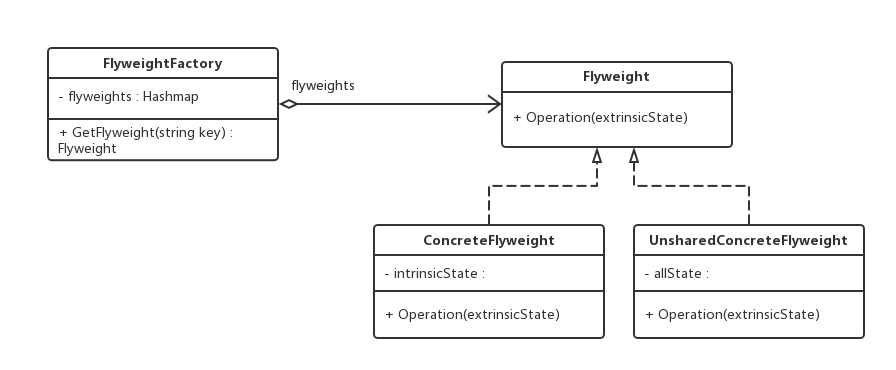简介
一、定义
1、概念
- 享元(Flyweight)模式:运用共享技术有效地支持大量细粒度对象的复用,是一种结构型模式。
2、理解
- 可以设计为享元对象的是相似度高、状态变化小,需要多次复用的细粒度对象;
- 设计享元对象是核心,关键在于内外部状态的分离,内部状态自行设置,外部状态需要运行传入(可以将外部状态设计为一个类);
二、组件
- Flyweight(抽象享元类):一个接口或抽象类,声明了具体享元类的公共方法。
- ConcreteFlyweight(具体享元类):实现了抽象享元类,其实例称为享元对象。
- UnsharedConcreteFlyweight(非共享具体享元类):并不是所有的抽象享元类的子类都需要被共享,不能被共享的子类可设计为非共享具体享元类。
- FlyweightFactory(享元工厂类):用于创建并管理享元对象,一般设计为一个存储 Key-Value 键值对的集合(可以结合工厂模式设计)。其作用就在于:提供一个用于存储享元对象的享元池,当用户需要对象时,首先从享元池中获取,如果享元池中不存在,那么则创建一个新的享元对象返回给用户,并在享元池中保存该新增对象。
三、结构图

示例(围棋)
一、外部状态类
public class Cordinate {
private int x;
private int y;
public Cordinate(int x, int y) {
this.x = x;
this.y = y;
}
public int getX() {
return x;
}
public void setX(int x) {
this.x = x;
}
public int getY() {
return y;
}
public void setY(int y) {
this.y = y;
}
@Override
public String toString() {
return "(" +
"x=" + x +
", y=" + y +
')';
}
}
二、抽象 & 具体享元类
public abstract class Chess {
public abstract String getColor();
public void display(Cordinate cordinate){
System.out.println("chess color:"+this.getColor()+"------cordinate:"+cordinate);
}
}
public class WhiteChess extends Chess {
@Override
public String getColor() {
return "white";
}
}
public class BlackChess extends Chess {
@Override
public String getColor() {
return "black";
}
}
三、享元工厂(简单工厂)
public class ChessFactory {
private static ChessFactory factory = new ChessFactory();
private static HashMap chessPool;
private ChessFactory() {
chessPool = new HashMap();
chessPool.put("white",new WhiteChess());
chessPool.put("black",new BlackChess());
}
public static Chess getChess(String color){
return (Chess) chessPool.get(color);
}
}
四、客户端代码
public class Client {
public static void main(String[] args) {
Cordinate c1,c2,c3,c4;
c1= new Cordinate(12,12);
c2= new Cordinate(13,13);
c3= new Cordinate(14,12);
c4= new Cordinate(12,15);
Chess b1,b2,w1,w2;
b1 = ChessFactory.getChess("black");
b2 = ChessFactory.getChess("black");
w1 = ChessFactory.getChess("white");
w2 = ChessFactory.getChess("white");
System.out.println("b1=b2:"+(b1==b2));
System.out.println("w1=w2:"+(w1==w2));
b1.display(c1);
b2.display(c2);
w1.display(c3);
w2.display(c4);
}
}
总结
一、优缺点
- 优点:可以极大减少内存中对象的数量,使得相同或相似对象在内存中只有一份 ,节省系统资源提高性能
- 缺点:为了使对象可以共享,享元模式需要将享元对象的部分状态外部化,而读取外部状态将使得运行时间变长
二、使用场景
- 一个系统有大量相同或相似的对象,造成了系统内存的大量损耗
- 对象的大部分状态都可以外部化,可以将这些外部状态传入对象中。
- 要维护享元模式,需要耗费一定的系统资源,因为在需要时会多次重复使用才值得使用享元模式了!





 本文介绍享元模式,它是一种结构型模式,运用共享技术支持大量细粒度对象复用。核心是分离内外部状态,设计享元对象。还阐述了其组件、结构图,以围棋为例展示代码。总结了优缺点及适用场景,可节省资源但读取外部状态会增加运行时间。
本文介绍享元模式,它是一种结构型模式,运用共享技术支持大量细粒度对象复用。核心是分离内外部状态,设计享元对象。还阐述了其组件、结构图,以围棋为例展示代码。总结了优缺点及适用场景,可节省资源但读取外部状态会增加运行时间。
















 537
537

 被折叠的 条评论
为什么被折叠?
被折叠的 条评论
为什么被折叠?








